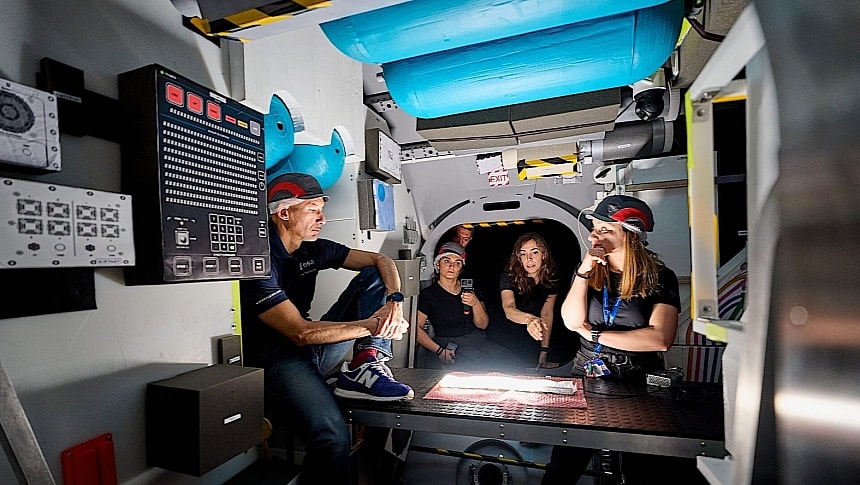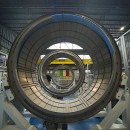Sometime very soon our species would have constructed its first-ever habitat in orbit around another celestial body. It's called Gateway, and it will be placed above the surface of the Moon to support the activities of the Artemis astronauts. That will happen quite soon, so a lot of fresh and exciting developments lie on the horizon.
Space agencies from several nations are working on the Gateway project: American NASA, European ESA, Japanese JAXA, and Canadian CSA. Supporting them are a large number of private companies, including SpaceX, Maxar, and Northrop Grumman.
The space station will comprise three major elements. They are the Power and Propulsion Element (PPE), the Habitation and Logistics Outpost (HALO), and the Lunar International Habitat (Lunar I-Hab). And it's the latter that's of particular interest to us today.
The Lunar I-Hab, being assembled in Europe, is the place where the astronauts will live and work, but also the place to house the life support systems and camera equipment.
Before sending it into space, the module needs to be thoroughly tested. For that to happen, an European company called Thales Alenia Space is working in parallel on two versions of the place: a full-scale replica of the module, and the one that will be sent into space in the near future for testing purposes.
The replica of the I-Hab is responsible for the latest development in the project. As promised in April, the European Space Agency started and completed human-in-the-loop testing of the hardware, focusing extensively on accessibility and maneuverability when inside the module. Everyday activities inside the module were also practiced.
The organization used real-life astronauts for the task, four of them. Three are part of ESA (Luca Parmitano, Rosemary Coogan, and Marcus Wandt), and one comes from American partner NASA - Stanley G. Love. Parmitano and Love are veterans of the International Space Station, while the other two are newbies in this business.
The tests with astronauts were performed at the Thales facility in Turin, Italy, and marks a "crucial step in the design and development of the module." The four were on site in a bid to identify problems with the interior design, uncover potentially hidden hazards, and make sure the tools and other gear are within easy reach.
Thales Alenia Space will use the input from the astronauts to adapt the design of the I-Hab that will actually go into space. The complexity of the replica will gradually increase and it will also start incorporating interfaces. When all tests have been performed, the module will enter the System Critical Design Review stage.
The Lunar I-Hab will fly to the Moon as part of the Artemis IV mission scheduled for 2028. The two other modules, the PPE and HALO, should already be on location by then, as they're scheduled to depart next year using a Falcon Heavy rocket.
The same Artemis IV crew that will deliver the I-Hab to lunar orbit is tasked with bringing the station fully online and preparing it for the first lunar surface mission that will use the Gateway as a staging post.
The space station will comprise three major elements. They are the Power and Propulsion Element (PPE), the Habitation and Logistics Outpost (HALO), and the Lunar International Habitat (Lunar I-Hab). And it's the latter that's of particular interest to us today.
The Lunar I-Hab, being assembled in Europe, is the place where the astronauts will live and work, but also the place to house the life support systems and camera equipment.
Before sending it into space, the module needs to be thoroughly tested. For that to happen, an European company called Thales Alenia Space is working in parallel on two versions of the place: a full-scale replica of the module, and the one that will be sent into space in the near future for testing purposes.
The replica of the I-Hab is responsible for the latest development in the project. As promised in April, the European Space Agency started and completed human-in-the-loop testing of the hardware, focusing extensively on accessibility and maneuverability when inside the module. Everyday activities inside the module were also practiced.
The organization used real-life astronauts for the task, four of them. Three are part of ESA (Luca Parmitano, Rosemary Coogan, and Marcus Wandt), and one comes from American partner NASA - Stanley G. Love. Parmitano and Love are veterans of the International Space Station, while the other two are newbies in this business.
The tests with astronauts were performed at the Thales facility in Turin, Italy, and marks a "crucial step in the design and development of the module." The four were on site in a bid to identify problems with the interior design, uncover potentially hidden hazards, and make sure the tools and other gear are within easy reach.
Thales Alenia Space will use the input from the astronauts to adapt the design of the I-Hab that will actually go into space. The complexity of the replica will gradually increase and it will also start incorporating interfaces. When all tests have been performed, the module will enter the System Critical Design Review stage.
The Lunar I-Hab will fly to the Moon as part of the Artemis IV mission scheduled for 2028. The two other modules, the PPE and HALO, should already be on location by then, as they're scheduled to depart next year using a Falcon Heavy rocket.
The same Artemis IV crew that will deliver the I-Hab to lunar orbit is tasked with bringing the station fully online and preparing it for the first lunar surface mission that will use the Gateway as a staging post.











